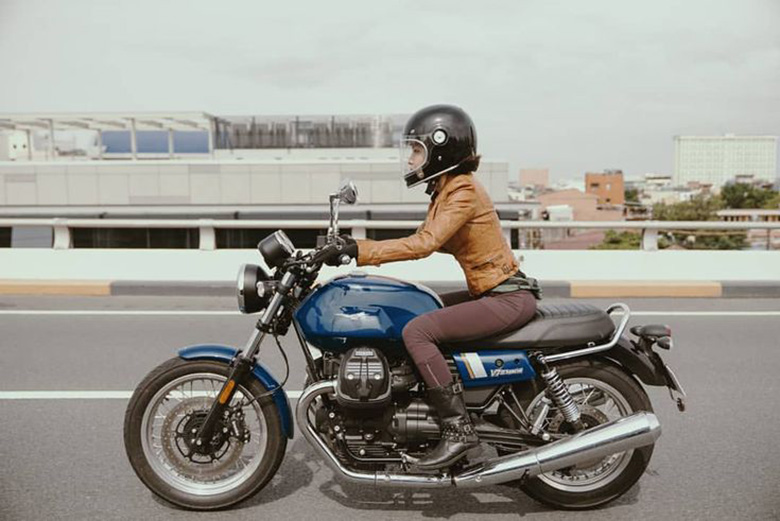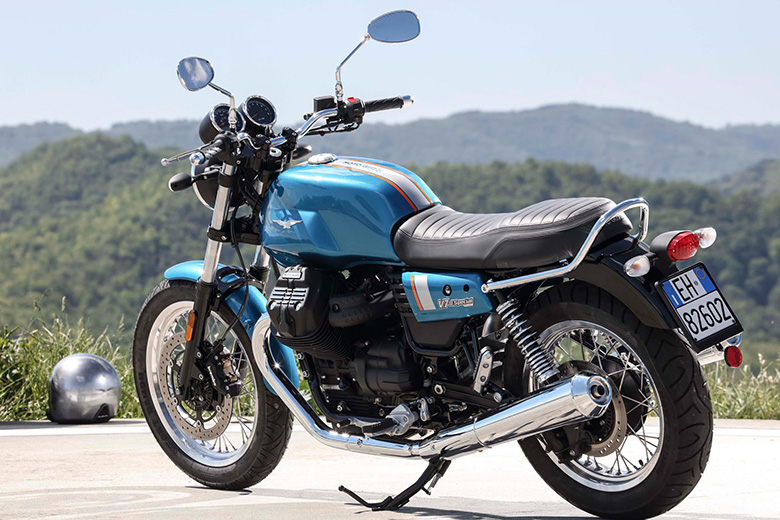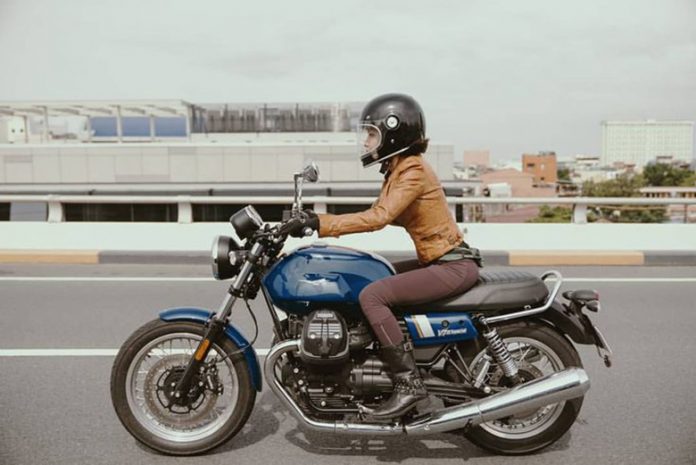The 2020 V7 is one of Moto Guzzi’s most popular and well-known motorcycles. This worldwide recognition stems from its ability to uphold the standards and reputation of a great brand like Moto Guzzi. The Moto Guzzi V7 has been a cornerstone of the product line since 1967, when the first units were launched in Italy. It represents the quintessential Italian motorbike, stands out for its substance and appearance, and is very popular among a broad spectrum of people.
Moto Guzzi V7 III is the third act of a unique drama that began more than fifty years ago with the debut of the first example. Given the fame and success of the V7, presenting the V7 III was one of the most challenging challenges. Since 2009, it has also been the brand’s best-selling model, serving as the Moto Guzzi’s entry-level bike.
Moto Guzzi 2020 V7 III Special Street Motorcycle – Features and Price

Riding Pleasurable
The V7 III keeps the model’s aesthetic individuality, with a form that communicates with shapes inspired by Moto Guzzi tradition while still meeting current motorcycle standards. The presence of twin-pipe exhaust manifolds and engine heads, both with oversized proportions, gives the feeling of being in the presence of a mature and robust bike, despite the V7 III proving to be one of the best and streamlined bikes. The metal fuel tank, on the other hand, has remained unchanged, with its superb 21-liter capacity and appearance inspired, as always, by the spectacular 1971 V7 Sport.
The injector covers and side fairings, with their streamlined design, also stand out for their elegant elegance. Each V7 III model features its saddle, complete with distinct graphics and coatings. Keeping with their reputation as necessary bikes, the V7 III Stone and Rough have a single circular instrument display. The rev counter is shown in a second circular display on the Special and Racer models. All other information is contained in the digital box, including the odometer, partial and daily trip (resets automatically eight hours after being switched off), trip time, instantaneous and average consumption, air temperature, average speed, and the MGCT (traction control) level, as well as the engaged gear indicator, for which the user can adjust the minimum and maximum rpm value.
Chassis
Moto Guzzi is known for its ability to create unique chassis. The V7’s enjoyable ride dates back to 1970 when the V7 Police was chosen to join the LAPD (Los Angeles Police Department) squad following a rigorous set of tests, establishing the Larian brand’s expertise on the subject even internationally. The steel frame retains the double-cradle tubular layout and the same weight distribution (46 percent front; 54 percent rear) as previous V7 generations; however, the third generation features an entirely revamped and reinforced front end with different steering geometry to ensure better dynamic performance through the turns, as well as better handling and stability. The meticulous care and finish of the details, particularly the welding and painting, has received particular attention.
The rear suspension system is comprised of a pair of Kayaba shock absorbers that are spring preloaded and give a progressive and controlled reaction in every condition, even while riding two-up, owing to their exceptional quality and the inclination of the mounting point to the frame. The low and forward arrangement of the footpegs ensures a comfortable sitting posture for the passenger. Because of the lower saddle (770 mm from the ground) and the proper understanding of the aluminum footpegs, the saddle-handlebar-foot peg triangulation is excellent for riders of all heights.
Engine
There are many excellent twin cylinder engines in the world, but only one transverse V, and that is the Moto Guzzi twin, who was born in 1967 thanks to Giulio Cesare Carcano’s brilliant intuition and is distinguished by a unique cylinder configuration that became an integral part of the bike’s design, like an authentic modern art metallic sculpture. It has reached its third iteration in the minor block variant. It has been redesigned compared to the unit that powered the V7 II to maximize riding enjoyment while ensuring improved performance and dependability.
The aluminum crankcase, strengthened at its core points, uses a crankshaft with calculated inertia to guarantee a pep and a good engine brake. The crankcase lubrication system is intended to disperse heat as efficiently as possible and decrease power absorption, ensuing in improved performance and lower fuel consumption. A ventilation system and a lower capacity oil pump capable of absorbing less power prevent power loss due to internal pumping of the crankcase chambers. The oil pump intake duct is brand new, as is the associated by-pass valve, and piston cooling oil jets including flow control and management valve, have been added. The blow-by gas output is located on the alternator lid.
The changes made a year ago also affected the top end of the engine, with entirely new aluminum cylinder heads, pistons, and cylinders in comparison to the V7 II, despite the bore and stroke, and thus the engine displacement, remaining the same, confirming the V7 III’s position as a Moto Guzzi entry-level motorcycle range. Timing is regulated by a new pushrod and rockers system with two valves per cylinder. However, they are positioned in an 0angled position in the head (which is more efficient). A single-body Marelli electronic injection system is in charge of the fuel system, controlled by an electronic control unit. Dual pipe manifolds are used in the exhaust system, which aids in thermal insulation. The Moto Guzzi twin 750 meets the Euro 4 criteria thanks to the auxiliary air system intake in its heads, the trivalent catalytic converter, the double lambda probe, and the engine architecture.

At 6200 rpm, the maximum power is 52 hp. In comparison, the maximum torque is 60 Nm at 4900 rpm, with a flat torque curve that promises simplicity of use paired with that distinctive Moto Guzzi character and swift reaction. A reduced-power version is also available, following the constraints imposed by the A2 class driver’s license, and is excellent for beginning Guzzi riders, which can also benefit from the V7 III’s overall weight and size, as well as the general ease of riding. The Moto Guzzi engine also features a 170 mm dry single disc clutch, which improves durability and reliability over time while reducing the load on the lever at the handlebar, all to the benefit of mouldability and riding comfort. The six-speed gearbox, which is accurate and smooth in shifting, is identical to the V7 II. Still, it now has a slightly longer first and sixth gear ratio, which is helpful for better using the engine’s torque and power capabilities.
Safety
When it comes to safety, Moto Guzzi has always been at the top of its game. The ABS braking system on the V7 III is adjustable, and the MGCT (Moto Guzzi Traction Control) system can be turned off. The first is a two-channel Continental system that keeps the wheels from locking up, while the second is a system that keeps the rear wheels from spinning during acceleration. The MGCT system has two sensitivity settings, one that is more conservative and appropriate for low grip circumstances such as wet or slick asphalt, and the other that is built for the excitement of riding safely on dry roads. Another feature of the MGCT system is the ability to re-calibrate the rear tire circumference to compensate for wear or the usage of a tire with a different profile than the original, ensuring that traction control remains exact.
Moto Guzzi 2020 V7 III Special Street Motorcycle – Price
The new Moto Guzzi 2020 V7 III Special is available at $8,990 only.
Moto Guzzi 2020 V7 III Special Street Motorcycle – Technical Specifications
Engine
| Capacity | 744 cc |
| Bore | 80 mm |
| Travel | 74 mm |
| Distribution | Two valves, having light alloy pushrods and rockers |
| Max Power | 38 kW (52 hp) at 6200 rpm |
| Maximum torque | 60 Nm at 4900 rpm |
| Exhaust system | 3-way catalytic converter with double lambda probe |
| Cooling | Air |
Chassis
| Frame | Double cradle tubular frame in ALS steel having detachable elements. |
| Wheelbase | 1445 mm |
| Trail | 106 mm |
| Headstock angle | 26.4° |
| Front suspension Travel: |
Ø 40 mm hydraulic telescopic fork 130 mm |
| Rear suspension
Travel: |
die-cast light alloy swingarm including two shock absorbers including adjustable spring preload
93 mm (80 mm shock absorber stroke) |
| Front brake | Ø 320mm of stainless steel floating discs, Brembo calipers with four differently sized opposed pistons |
| Rear brake | Ø 260mm of stainless steel disc, floating caliper including two pistons |
| Front-wheel | 18″ in the lightweight alloy (spoked for Special/Racer/Rough) 100/90 (110/80 R18 alternatively) |
| Rear-wheel | 17″ in lightweight allow (spoked for Special/Racer/Rough) 130/80 |
Dimension
| Seat height | 770 mm |
| Length | 2,185 mm |
| Height | 1,100 mm |
| Minimum ground clearance | 150 mm |
| Fuel tank capacity | 21 liters (including 4-liter reserve) |
| Dry weight | 189 kg (Special, Rough 193 kg) |
| Kerb weight | 209 kg (Special, Rough 213 kg) |
Others
| Consumption (WMTC cycle) | 5.5 l/100 km (Racer 5.7 l/100 km) |
| CO2 Emissions (WMTC cycle) | 128 g/km (Racer 132 g/km) |
Conclusion
The new Moto Guzzi 2020 V7 III Special Street Motorcycle is an impressive motorcycle with many exciting features, including a powerful engine and stylish chassis. The bike has got a comfortable seat and a perfectly tuned suspension system. The handlebars give maximum control in the hands of the rider.

